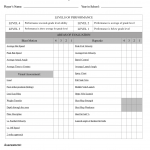To Bunt, or not to Bunt
The debate between baseball lifers and baseball stat nerd (I happen to be BOTH!) really heats up when the topic of bunting comes up. The problem is both seem to be very absolutist about their view. Baseball lifers love bunting and wax poetic about its virtues. Stat nerds view bunting as if the offending team is just giving up and is not interested in scoring. As you might imagine, being both a “baseball guy” and a stat nerd, I have a bit more of a balanced approach.
It is a fact that the team who generates more big innings (three runs or more) wins the game a large majority of the time. It is difficult to sustain offense by scoring single runs in an inning, and it is difficult to generate big innings when giving up outs. In amateur baseball, you only get 21 of them. Make three outs on purpose by "sacrifice bunting" and you have just given away an entire inning.
There are instances where a pure sacrifice makes some sense. If you are trailing by a single run, or tied late in the ball game, moving a runner from second to third with nobody out (sacrifice resulting in the first out) will increase a team's chances of scoring exactly one run, but decreases their chances of scoring more than one.
So if the value of bunting is not giving up an out to advance a runner 90 feet, how do I satisfy the baseball guy in me? It’s simple. Use the bunt to generate big innings.
Change the paradigm of your bunting game. Don’t make it a passive “I’m giving myself up for the good of the team” action. Even though this is a good lesson for players, that lesson can be taught in other ways. Make bunting an aggressive “I’m trying to create havoc” action. Emphasize the bunting game in practice to the point where players are able to execute bunts that are difficult to field. Bunts back to the pitcher or that be easily fielded by the pitcher to do not accomplish this goal.
Teach your players to bunt so that the third baseman has to field it, and has to make an off balanced throw. Remember the goal is to create havoc and put pressure on the defense.
Below are the list of outcomes from bunting from best to worst:
1.) Defense commits an error, runners and better advance several bases.
2.) Baserunner and batter are both safe.
3.) Baserunner advances, but the batter is out.
4.) Lead runner gets thrown out.
5.) Strikeout, no runners advance.
6.) Double play.
Since the goal of bunting is to create havoc, only outcomes one and two are viewed as positive. Outcome three, advancing runners, but making an out is a neutral result, and outcomes four through six are negative.
More detailed information on using the bunting game to create big innings, the techniques of bunting, bunting for a hit, and squeeze bunting can be found in our Generating Offense and Hitting online course which is just a small part of our whole site membership.
For more great baseball coaching content like this, check out our complete website membership which includes all of our online courses, special video tips, and mini clinic available to members only, monthly video analysis, eBooks, video lessons, and much more!
Our "Small Ball, Big Innings" online course is just the tip of the ice berg in our Cornerstone Elite membership. Check it out here:
 Posted by Kyle Nelson
Posted by Kyle Nelson- Posted in Coaching Philosophy, Small Ball
 Nov, 26, 2013
Nov, 26, 2013 10 Comments.
10 Comments.
Elite members login here
Check out what’s New/Hot!
Recognizing, Diagnosing, and Fixing Common Hitting Flaws eCourse The 3 metrics we tested on Blast motion sensors this year Sneak Peek Inside an Elite Q and A The batting practice continuum Elite Member’s area table of contents 50+ “Chaos” hitting drills
5 sample Chaos hitting drills FREE
Mental Skills and Culture Building The hitting pyramid Welcome Elite Member, Trey! Ideas for a pitcher first practice 12 week bat speed improvement plan Make plans this offseason to have your team playing their best baseball at the end of the year” Top 5 hitting drills to translate practice skill to game performanceHow we used Blast Motion sensors with a team in 2019
What to do if your hitters are overmatched Welcome Elite Member, Tommy! Setting your baserunners up for success Welcome Elite Member, Mike! A consulting call with Elite Member Matt FREE Web Clinic: Developing Athletic, Consistent, Extraordinary Infielders
 Coach Kyle Nelson
Coach Kyle Nelson






Especially at the HS level with BBCOR bats this is 100% true. It is harder than ever to score from 2nd on a base hit to right as RF ers move in without fear of a ball over the head. Havoc based but offense is a great way to put that!
At the MLB level, a “sacrifice bunt” will almost always result in an out. That is far from true as you move down the ranks. I look at bunting similar to putting on a press in basketball. Why do we do it? Because we believe we can put pressure on the opponent and force them into mistakes.
The BBCOR era certainly has changed things. At first I didn’t like it, but after getting used to it, I enjoy the games much more.
I can’t speak to the high school level, or MLB because I coach college players.
First, the bunt is central to a team offensive ethic. It’s probably the easiest hitting task. Hitters don’t do it well because they’d rather swing the bat. Until a bunt ethic is established, all execution is diminished in the players’ eyes. Bunt execution must be EXPECTED.
Second, a single bunt execution (for one run)is useful to get the lead against a tough opponent in any inning. Trading an out to get into scoring position makes sense because,when it results in a 1-run lead, the opposing team must score a run to tie. That’s momentum, and momentum affects the way people play.
To create defensive havoc, multiple sacrifice bunts are required — along with a sprinkling of steals, taking extra bases, and bunts for hits; combined with an occasional extra-base hit.
As to MLB, I would point out that many World Series champions in the past decade have used the above formula to create havoc and win. The same is true of almost every World Baseball Classic champion since that series began.
I’ve coached both high school and college (briefly) and the comparison I can make in regard to bunting is this: College infielders are much more likely to get an out on a bunt than high school infielders. Putting high school infielders in an uncomfortable situation where they have to throw on the run or field in an odd position is usually an offensive recipe for success.
I advocate bunting as an offensive weapon to generate big innings. As you mention, combine that with other offense weapons and a few big hits, and now you have a seriously productive offense!
Agreed.
However, one should not underestimate the value of gaining a 1-run lead. It changes the pressure on the opposing team and forces them to approach offense and defense differently than being tied or ahead.
I feel like if I was a prize fighter (that’s a HUGE leap) I would be the guy trying to knock my opponent out in the first couple of rounds instead of trying to win round after round and win in a decision at the end.
Don’t get me wrong, scoring a run is positive, I just always look for that knockout early in the game.
Happy Thanksgiving and thanks as always for your comments!
Trading an out to move a runner into scoring position makes no sense. The key phrase is “when it results in a run” because, statistically, it doesn’t result in a run more often than it does. So, as your opponent, you do me a favor by giving me an out. It’s a move employed by coaches playing not to lose. A 1-0 early game deficit doesn’t change the way ANY game is played or coached. How many 1-0 games did your team win? Not very many.
The whole BBCOR argument is a red herring. Good hitters hit with any type of bat. Teach the players to hit, and you’ll score runs. Play not to lose and most of your games will be close and you’ll lose as many as you win.
Utilizing a running game, and the hit and run puts more pressure on a defense than bunting does and leads to more big innings. It also puts your team in an aggressive mindset that translates into greater confidence.
Coach Waite, great to hear from you! I hope you and your family had an excellent Thanksgiving.
Here are the results from our bunting last year… I realize this is a small sample size, but that’s all you get in a high school season so the burden of proof here, statistically speaking is not very high.
We bunted 28 times last year. Four times our opponent made an error that resulting in multiple bases, we scored on two of those. Seven additional times our opponent did not get an out either because of us beating it out (bunt for hits with nobody on are not counted), a miscommunication or trying and failing to get a lead runner. Nine times we made and out and advanced the runner. Four times the lead runner was out. We had three strikeouts and a one double play. I didn’t record this, but I remember we got back picked once at second on a ball that was bunted through.
So in almost 40% of our bunts, we didn’t make an out. Without looking back, I’d guess the OBP of the players we had bunting was nowhere near .400. I wouldn’t take the bat out of someone’s hand with a .400 OBP. Likewise, their SLG% was also likely low since the middle of our order (2-5) didn’t bunt at all.
Something that doesn’t show up in the numbers is that we don’t really “sacrifice” bunt. Meaning, if the first try fails, it usually doesn’t get counted because we take it off. So there were probably a dozen or more times where we put ourselves down 0-1 by bunting through a pitch, bunting it foul (because we are trying to put the ball right on the line) or taking a strike. So I’m not sure how much that would be factored into the equation, but it certainly has a negative effect.
What does all that mean, maybe nothing because of the small sample size, but I am going forward on the premise that bunting doesn’t have to equal making outs. If you pick and choose your spots (especially in high school) and teach players to bunt well, it can actually be pretty productive. As you move up to college and pro ball, and infielders get better, the percentage of outs they will make goes up, and it becomes less effective.
It was the first year I kept track of it, so maybe I’ll have a clearer picture in 5 years.
Thanks for reading Coach!
“I’m trying to create havoc”…love this quote. As a High School varsity baseball coach, executing the bunt properly will win you games. I will never forget hearing an opposing player say “they had to bunt to beat us.” As we were packing up our dugout and walking off their field with the state tournament berth clinched I said to myself…”exactly!”
I know the analytics say that statistically, you are giving up outs and that decreases your chance to score runs. But, at the high school level, chances are a lot higher that the defense will throw the ball away, bobble the ball/runner beats it out or throw to the lead base under pressure and we beat the throw. If I have a good bunting team, I’m going to lay it down time and time again.
Coach Kuebler
wwww.ColonialBaseballInstruction.com
Coach K-
That is exactly what we are banking on. In 2014, if you count errors in OBP (which I know you don’t but for the purposes of bunting I feel we “forced” those errors in some cases) we got on base at a higher rate when we bunted than when we didn’t.
Obviously it wouldn’t hold true if we just bunted all the time, and there are several players in our lineup that I wouldn’t want to take the bat out of their hands. However, if used at the correct time, bunting can be an offensive weapon.
Kyle